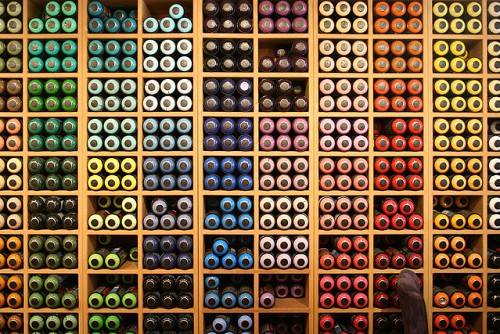Matte vs Glossy Paint
Which sheen of paint to use is the eternal question of DIY painters (not to mention conscientious painting pros looking to make sure clients get exactly what they want). And if you've looked into your options for paint formulas, you already know that the seemingly simple choice between matte vs glossy paint includes many shades of gray (and every other color of the rainbow). However, there are a few reliable, practical considerations to guide your decision, as well as some more subtle aesthetic factors that can be just as important.
Sheen Means Shine
Generally speaking, sheen relates to how shiny or glossy a paint is. Getting slightly more scientific, shine relates to how much a paint reflects light. Matte paint reflects relatively little; glossy paint reflects a lot more. The play of light on a painted surface affects not only what we see, such as color quality and surface texture, but it can also have an emotional impact: think of how different the same photograph can look and feel with a matte vs a glossy finish.
The Sheen Spectrum
The difference between matte vs glossy paint represents the range of commonly available sheens. Moving up the scale from lowest to highest level of shininess, there are:
- matte, or flat
- eggshell
- satin
- semi-gloss
- gloss (also called high-gloss)
Some paint manufacturers offer eggshell or satin but not both; if they do offer both, satin typically has slightly more sheen than eggshell. The names and relative degrees of all sheens can vary by manufacturer. Conventional paints, when dried, essentially create a very thin film of plastic made up of pigments and binders, or resins. Paints with higher sheen have a higher proportion of binder than lower-sheen formulas, creating a more elastic membrane with a smoother, less porous surface.
Practical Matters
Most painters choose a paint sheen based on 3 factors: washability, reflectivity, and the condition of the surface to be painted. Let's break those down as they relate to matte vs glossy paint.
- Washability. The low porosity and smoother, harder finish of glossy paint makes it highly washable and less prone to permanent stains and scuff marks. When you scrub a glossy paint with a damp sponge, the dirt comes off but not the paint; with matte paints, some of the paint color ends up on the sponge, and the dirt is harder to remove. Glossier paints also are more moisture-resistant and generally more durable.
- Reflectivity. The glossier the paint, the more it will reflect light. Reflective surfaces have a stronger visual impact (they "pop" more) and tend to provide greater depth of color. This factor makes glossy paint the obvious choice for decorative features such as accent walls.
- Condition of the surface. Consider the condition of surface you plan to paint. Because matte paints reflect less light, they visually smooth out variations and imperfections on the underlying surface. Glossy paints do the opposite, highlighting bumps and textures and creating more glare.
Which Sheen Goes Where
Ceilings are best with minimal glare. They also don't get touched often, so washability is not a big concern. Therefore, matte paints are preferred for ceilings.
Walls are in the middle: some reflectivity is desirable, as it adds depth of color and helps brighten a room, but too much gloss creates an unpleasant glare. At the same time, washability is important, so the best balance among all of these factors is an eggshell or satin paint for walls…in most rooms: some painters prefer the higher washability and moisture-resistance of semi-gloss for bathroom and kitchen walls.
Trim, cabinetry and doors need the washability and durability of glossy paint because they get handled (and kicked, bumped, and scraped) a lot. The smooth surfaces of these materials provide a good base for high-sheen paints, and their areas are relatively small, so the shininess doesn't overwhelm the eye or create too much glare.
Sheen Affects Color
If you buy three samples of paint in the exact same color -- one matte finish, one eggshell, and one high-gloss -- and paint them onto the same wall, you'll get a clear demonstration of how sheen affects color. Often, the different sheens actually look like slightly different colors. That's why it's a common technique to paint walls in a low- or medium-gloss sheen such as eggshell or satin, and adjacent trimwork in the same color but in semi-gloss or gloss. The crisp, shiny look of the trim stands out against the softer, warmer feel of the walls, creating just enough contrast to enhance both elements.
For some reason, many paint suppliers offer samples in only one sheen of paint (often matte). If you choose a paint color based on a sample of matte but you're using semi-gloss for the real project, you might be unpleasantly surprised at the results. The aesthetic effects of sheen are particularly pronounced on highly textured surfaces, which are loaded with light-reflecting contours directed at all angles. If your local paint store or home center won't provide samples in your chosen sheen, find another paint supplier or buy a small quantity of paint in the color and sheen you want to try a test run before you buy the paint for the whole job. Keep in mind you can create a custom blend by mixing different sheens of the same color. To ensure consistency, try to mix one batch for the entire project.
Philip Schmidt writes for Networx.com.
Updated June 10, 2018.
Looking for a Pro? Call us (866) 441-6648

Painting Average Costs
Painters Experiences

Find A Painter Willing To Work With The Style YOU Have In Mind

A Quality Interior Painting Project




